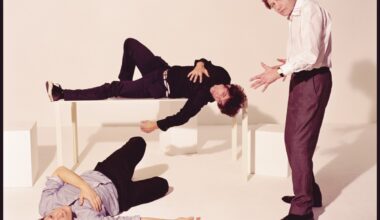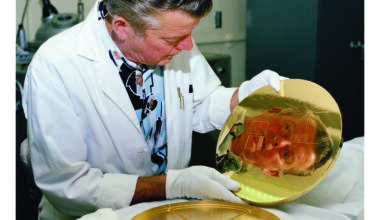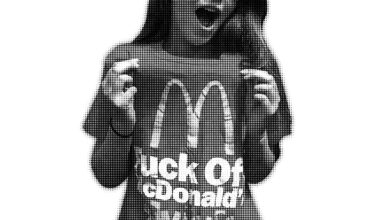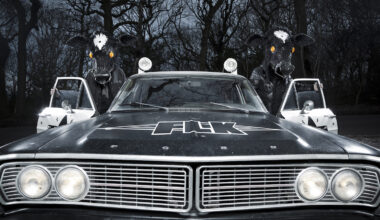In 1978, Nurse With Wound lynchpins Steve Stapleton and John Fothergill were unknown noise merchants. Then they made a list that would accidentally become the guiding light for experimental music creators

The Nurse With Wound list has been described as “the most notorious record collecting document there is” (The Quietus), “the most influential weird music list ever” (LA Weekly), and “the Rosetta Stone of obscure music” (a lot of people).
This roll of 291 artists – part idiosyncratic syllabus, part love letter – has become a beast in its own right, its influence travelling far beyond the wildest expectations of its creators, Steve Stapleton and John Fothergill. Records by featured artists – among them Kraftwerk (strictly up to ‘Autobahn’), Throbbing Gristle and Alternative TV – have become prized by collectors and retailers alike, often demarcated with the mysterious abbreviated “NWW” sticker – initials, the classification suggests, for those in the club.
Back in 1978, however, it did not feel like a club. The list was conceived as an insert for Nurse With Wound’s debut album, ‘Chance Meeting On A Dissecting Table Of A Sewing Machine And An Umbrella’, which the London noisesmiths released the following year. They pressed 500 copies and had little expectation of shifting those, let alone creating the defining document of avant-garde music.
“We didn’t know what its role was,” says Steve Stapleton. “It was a cry, a combination of our knowledge and, well, we wanted to meet other people. The subtitle was, ‘If you love eccentric, experimental music, then contact us’, and we put our addresses on there. At the time, there were no publications for it, there was nowhere you could go and find out about any of these weird artists, so we were reaching out to other people who were interested in the same stuff.”
The NWW list is often thought of as a starting point, but back then, for Stapleton and Fothergill, it was more a summary of their journey thus far.
“We argued about it for maybe three months,” says Stapleton. “We had to hone it down from thousands of names. And also, there are great gaping holes on there! There are people we think now, like, ‘Why the fuck wasn’t Miles Davis on there!?’. But that’s as far as we’d got in our investigations.”
Those investigations had begun long before, around 1970, when Stapleton was 13 years old and first heard ‘Sister Ray’ by The Velvet Underground. Already frustrated with rock music’s habit of fading out the freak-out at the end of a track – “the most exciting part” – ‘Sister Ray’ was a beacon of hope.
“It felt like this was the hidden stuff, the stuff they always faded out,” says Stapleton. “But here we have it glorified. It was only when I discovered German music that I realised, ‘Man, they’re totally into this kind of thing!’, and it really struck a chord with me. There was so much of it around then, and it was in all forms of culture around the world in those years between 1968 and 1974 – before everything was sucked into the great commercial cement mixer. Everybody was taking chances.”
Determined to hear as much as possible, Stapleton’s musical exploration soon became a geographical one, as he and his eventual bandmates John Fothergill and Heman Pathak took off to all corners of Europe in an obsessive pursuit of the artists, labels and record shops that were helping to push the boundaries.
“I spent years travelling around Europe, meeting artists and basically being a groupie to bands that I liked,” says Stapleton. “I remember going to Paris and looking up the address for the Futura label [home to listee Jac Berrocal] and finding this basement with a middle-aged woman sitting behind a desk doing the ironing. She said, ‘The guy’s out at the moment, but here you go – you can have this and this and this’, and she gave me, like, 20 albums!”
Those records were rare at the time, but now that stack alone could be worth north of £30,000, although that’s not the point. It was the hunt, the experience, like meeting Pilz label founder Jürgen Schmeisser, the man who signed Kraftwerk and ensured that Vertigo issued ‘Autobahn’, despite the poor sales of ‘Ralf And Florian’ putting the group’s future in doubt.
“Jürgen gave us all the Pilz albums, artwork, all sorts of stuff. He was thrilled that people were interested.”
Not every trip was so successful, of course. Most notably, the time they went to Faust’s studio in Wümme, just outside of Hamburg.
“I made that trip with Heman Pathak,” recalls Stapleton. “We got all the way, found the studio, which was an old school house, and no-one was there. So we ended up sleeping in a freezing bus shelter that night, then the next night we slept under the autobahn in a ditch. Years later, that story got back to Jean-Hervé Péron, the bass player of Faust. He rang me up and he said,
‘I know you tried to get here, so now Faust are going to try to find your house in Ireland’. So that’s what they did, which I thought was really nice.”
The unexpected impacts of the NWW list – the bands discovered by the wider world, the groups formed under its influence, the relationships and memories it documents – continue to resonate, as does its enigmatic quality. Even now, amid the full modern media buffet, many entries – selected for a single track or one side of an album – are nigh-on impossible to locate. Even though Stapleton has teamed up with Finders Keepers, masters of digging out obscure copyright, to issue a series of compilations dubbed ‘Strain, Crack & Break’, it’s likely that some will remain mysteries for a long time yet.
The element of surprise is part of the list’s charm, but does Stapleton ever fret about its legacy, particularly as it exceeds that of Nurse With Wound itself?
“I don’t really,” he says. “It was just an insert to an album that we thought no-one would buy. We didn’t think we’d sell 500 copies, so it’s amazing. I still make music, I still release records, I’m still doing what I love, but the list is a thing on its own. It’s a Frankenstein’s monster. It’s gone off and done its own thing. For me, though, it’s like a pictorial trip down memory lane.”
The first of the Nurse With Wound list compilation albums, ‘Strain, Crack & Break: Volume One (France)’, is on Finders Keepers





